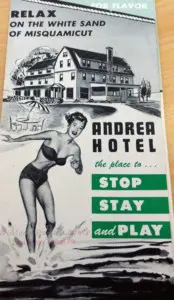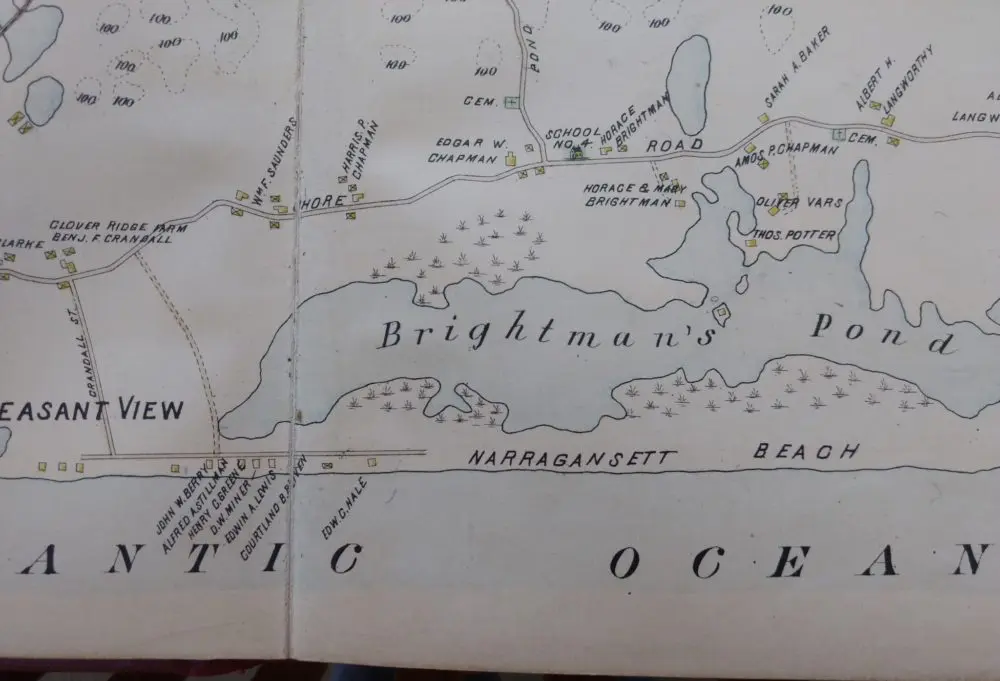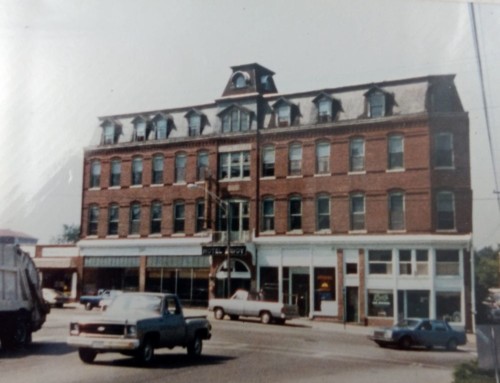In the days before automobiles were in every home, getting to and from Pleasant View could be quite a struggle. That was until December 1911, when the Westerly and Norwich Traction Company extended their trolley line to Pleasant View, giving residents and visitors a direct line to downtown Westerly.[22] In 1922, during the peak season, the Shore Line Electric Railway Company ran from hourly from 6:45 a.m. to 10:45 p.m., allowing visitors to spend a full day enjoying all the beach had to offer.[23]
According to one history of the area, a 50-foot lot could be purchased for just $50 in 1903 (approximately $1,425 dollars today).[24] In 1915, the same size lot would cost about $1,000 (approximately $25,000 today).[25] As the area became more developed, the need for public services and utilities grew. In 1908, the United States Post Office Department opened a post office in W.D. Main’s grocery store, where it remained until 1914 when it was moved to Winnapaug Grocery.[26]
In 1910, Westerly Water Works installed city water in Pleasant View and the following year, Westerly Light and Power Company installed electric street lights.[27] As the summer population of Pleasant View increased with each passing season, so did the amount of local entertainment. In 1911, Atlantic Beach Casino, a roller skating rink, opened, and it still exists today as the Windjammer.[28]
Growth in the area continued at an exponential rate over the next several years. In 1913, there were 129 buildings listed in the area directory and two years later, that number was up to 145.[29] While the total number of buildings grew by sixteen between 1913 and 1915, this does not account for the several that were damaged in a storm on March 2, 1914, including five cottages that washed up on the beach.[30]
By the 1920’s, Pleasant View had nearly every type of business that one could ever need including grocers, barbers, bakers, automobile repair, and even an attorney.[31] In 1915, the Pleasant View Fire District was established and in 1926, the company constructed a new firehouse in Post Office Square at the intersection of Atlantic Avenue and Winnipaug Road.[32]
The Misquamicut Era, 1928-Present
On October 1, 1928, at the request of the United States Post Office Department and with a great deal of local support, Pleasant View’s name was changed back to the area’s original name, Misquamicut.[33] In many ways, this was more than just a name change, but also the signaling of the start of a new era. By the end of the 1920’s, automobiles were becoming more popular and as a result, Westerly residents could more easily spend a day at the beach without having to invest so much time in travel.
In 1929, another hotel, the Misquamicut House, opened, however, its tenure was relatively short, as the building was one of the many destroyed in the Hurricane of 1938.[34] Throughout the 1930’s, Misquamicut continued on as a popular resort destination for visitors and locals.
Catastrophe struck in September 1938 when a devastating hurricane ravaged the area. Homes and businesses were destroyed in the storm and a great deal of rebuilding was required. A great deal has been said on many occassions about the hurricane’s impact on Westerly and, specifically, Misquamicut.
Within two years, some of the buildings which were impacted by the hurricane including the aforementioned Pleasant View House and St. Clare’s Chapel were reopened.[35] Tourism to the beach, like many industries, was curtailed by the onset of World War II. In the post-war era, much remained the same as before the war, with many visitors to the area arriving each summer. Another storm wreaked havoc on the area in 1944, and just sixteen years after the Hurricane of 1938 decimated Misquamicut, a third powerful storm struck.

Although Carol’s effects were severe, the late 1950’s marked the start of positive changes for Misquamicut. In the second half of the decade, efforts to acquire a State Beach for Misquamicut were successful. In December 1958, estimates for the cost of the project were given at $600,000 with $112,000 to be contributed by the town of Westerly.[39] In May 1959, ground was officially broken for the project and the following month, Misquamicut State Beach was officially opened.[40] Now, for the first time, visitors from other states were able to take full advantage of the area’s beaches.
The 1960’s was a decade of ups and downs for the area. In May 1960, sand fences were constructed in Misquamicut, allowing for the preservation of dunes at the State Beach where many important species reside.[41] That same year, Misquamicut suffered a potential environmental disaster when the tanker P.W. Thirtle of the Sinclair Refining Company ran aground in Jamestown, Rhode Island, and spilled 339,000 of gallons of oil into Narragansett Bay.[42]
Within days, reports came in stating that a “thick black scum” was visible as far away as the Pawcatuck River.[43] Eventually, the oil was cleaned up and by the next season, Misquamicut returned to its status as a premier tourist destination. By 1971, one study indicated that Rhode Island State Beaches, including Misquamicut, were visited by over one million people each year.[44]
Over the next several decades, Misquamicut continued to be a popular summer destination for locals and tourists. In the 1980’s and 1990’s, Peter Pan Bus Line advertised direct trips to Misquamicut from Western Connecticut and Massachusetts.[45] In addition to sun, sand, and surf, the 1990’s brought consistent popular entertainment to Misquamicut every summer.
In 1990, the Windjammer (formerly Atlantic Beach Casino) featured acts such as Sawyer Brown and, controversially, 2 Live Crew.[46] Despite efforts to block the latter’s performance, the group was featured at the Misquamicut venue and drew hundreds to the area for the show.[47]
In 2000, the Misquamicut Business Association was formed, and in the years since their founding, they have made Misquamicut a destination for the whole family. Over the last two decades, they have developed a series of successful events which have drawn a large number of visitors to the area, such as Spring Fest, which has been held every year since 2010.
In 2012, Misquamicut was struck by Superstorm Sandy, which brought destruction and devastation to the community. Through the perseverance and dedication of the residents and business owners, Misquamicut has successfully rebounded to return to a wonderful place to visit for locals and tourists alike. Over the last 125 years, Misquamicut has remained a destination for all who seek fun and sun on the Rhode Island shore.
[su_accordion class=””] [su_spoiler title=”Footnotes” open=”no” style=”default” icon=”plus” anchor=”” class=””]
- Mermet, R.E., “The Shore Line Electric Railway” The Marker, vol. 5, No. 3.
- The Gray Book or “What You Want to Know” of Pleasant View, R.I. for Season of 1922, The Shore Line Electric Railway Company Schedule.
- Illustrated Description, History and Directory of Pleasant View Beach, 2nd Edition, (1915), pg. 13.
- Illustrated Description, History and Directory of Pleasant View Beach, 2nd Edition, (1915), pg. 13.
- Illustrated Description, History and Directory of Pleasant View Beach, 2nd Edition, (1915), pg. 13.
- Illustrated Description, History and Directory of Pleasant View Beach, 2nd Edition, (1915), pg. 13.
- Gentile, Donald L., “Pleasant View Has a New Name,” Booklet Courtesy of the Westerly Historical Society.
- Illustrated Description, History and Directory of Pleasant View Beach, 2nd Edition, (1915), pg. 14.
- “Pleasant View Cottages Wrecked by Wind and Tides” Westerly Sun, 2 March 1914.
- The Gray Book or “What You Want to Know” of Pleasant View, R.I. for Season of 1922, Business Guide.
- Gentile, Donald L., “Pleasant View Has a New Name,” Booklet Courtesy of the Westerly Historical Society and Misquamicut Fire District Charter and By-Laws, 2019.
- Gentile, Donald L., “Pleasant View Has a New Name,” Booklet Courtesy of the Westerly Historical Society and “Pleasant View, R.I., Now Misquamicut Beach” Brooklyn Daily Eagle, 30 June 1929.
- Gentile, Donald L., “Pleasant View Has a New Name,” Booklet Courtesy of the Westerly Historical Society.
- “To Dedicate a Chapel at Misquamicut” Westerly Sun, 8 August 1940.
- “Martial Law Declared in Rhode Island, Five Known Dead, Millions in Damages” Boston Herald, 1 September 1954.
- “Misquamicut Evacuees Lug Their Belongings on Their Backs” Springfield Union, 1 September 1954.
- “Damage at R.I. Beach Exceeds that of 1938” Springfield Union, 1 September 1954.
- “Many Property Owners Will be Affected in Beach Work” Westerly Sun,18 December 1958.
- “Ground Officially Broken for New Beach” Westerly Sun, 11 May 1959.
- U.S. Army Engineer Division, North Atlantic, National Shoreline Study, Regional Inventory Report, vol. I, pg. 75.
- 1960 Press Photo Tanker P.W. Thirtle spills fuel Into Narragansett Bay, RI, photo caption, and “Countil Meeting Called; Black Scum Coats Shore” Newport Daily News, 6 September 1960.
- 1960 Press Photo Tanker P.W. Thirtle spills fuel Into Narragansett Bay, RI, photo caption, and “Countil Meeting Called; Black Scum Coats Shore” Newport Daily News, 6 September 1960.
- U.S. Army Engineer Division, North Atlantic, National Shoreline Study, Regional Inventory Report, vol. I, pg. 29.
- Peter Pan Bus Lines Advertisement, Hartfort Courant, 2 June 1981.
- Catlin, Roger, “Clegg and Savuka Step Out from Behind Chapman’s Shadow” Hartford Courant, 11 October 1990 and “2 Live Crew Plans Stop at New London Store” Hartford Courant, 6 October 1990.
- Catlin, Roger, “2 Live Crew Not as Bad as They’ve Been Touted” Hartford Courant, 8 October 1990.
[/su_spoiler] [/su_accordion]






